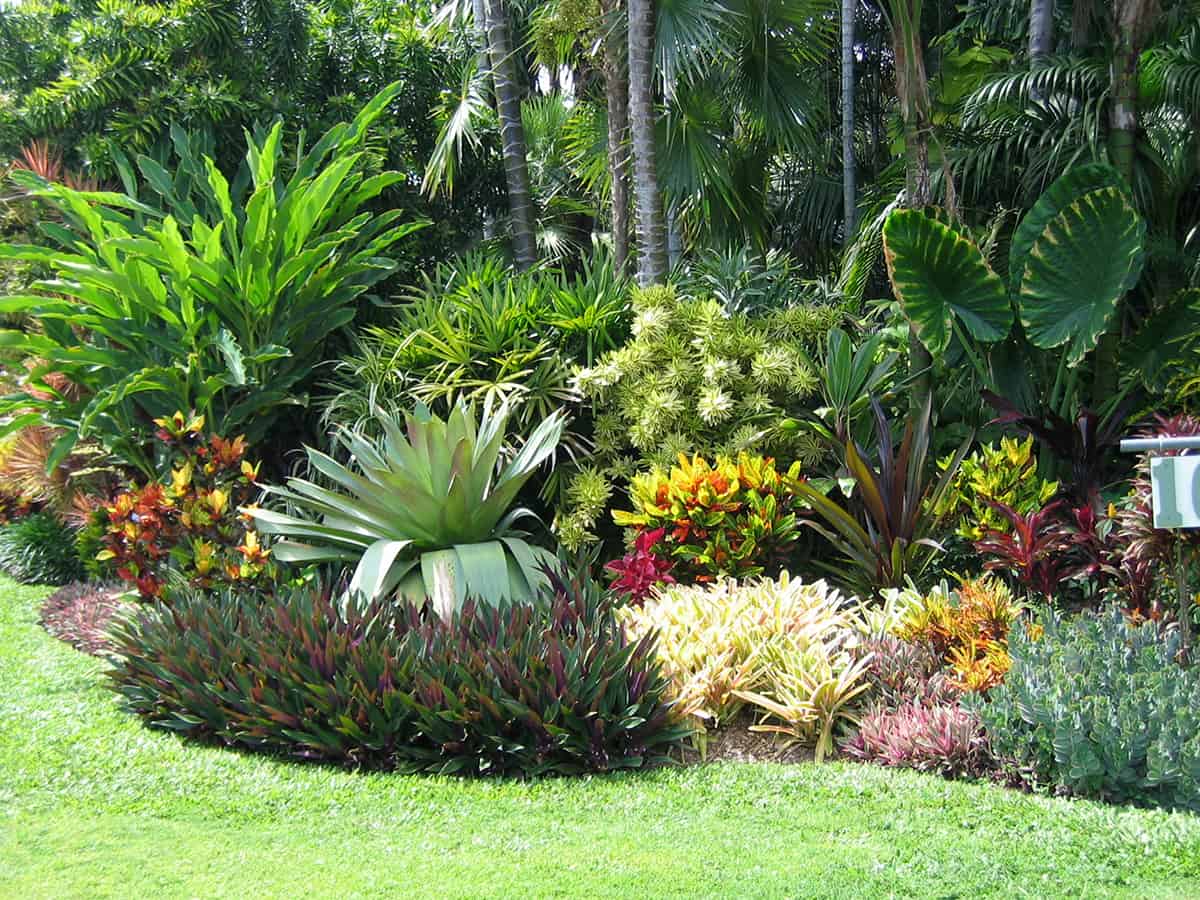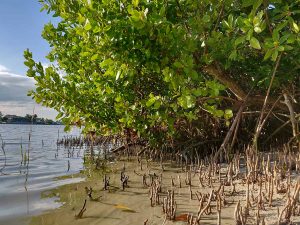Flowering shrubs which are native to tropical and subtropical regions will be accustomed to growing in warm or hot climates, so these are an ideal type of plant to grow in your garden if your local climate can replicate tropical conditions.
Tropical flowering shrubs can add a stunning aesthetic to a garden since they typically have vibrant and unusual blooms. Here we take a look at some of the most popular tropical flowering shrubs available.
Table of Contents
Benefits of Tropical Flowering Shrubs
Vivid color
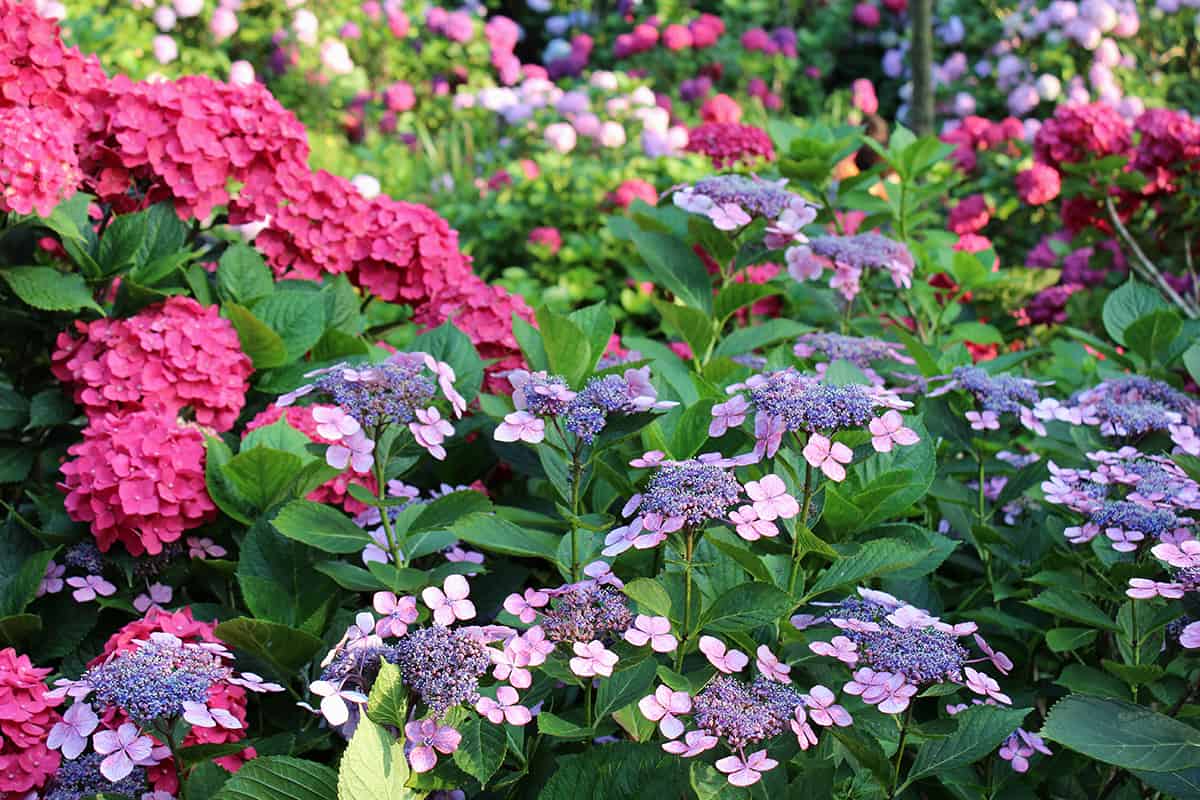
One of the most common reasons people favor tropical flowering shrubs over native flowering shrubs is the intensity of the color of exotic flowers.
Tropical flowers come in a plethora of colors that tend to be bright, bold, and uplifting, such as hot pink, deep orange, intense violet, and shocking red. This type of color palette can make for a really fun atmosphere in the garden, and it works really well if you are trying to achieve an exotic aesthetic.
Fragrance
One of the great benefits of tropical flowers is that they often emit heady fragrances. The addition of scented flowers in the garden can elevate the overall appeal of the space and really serve to ignite your senses when you spend time outside.
For the ultimate enjoyment, plant scented tropical flowering shrubs around picnic benches or patio areas so that they will be close enough for you to enjoy their fragrance.
Attract pollinators
Pollinators such as butterflies and bees are essential for maintaining our existence on the planet, so the more flowers we can plant to keep pollinator species alive will benefit all of us. Tropical flowers are popular among pollinators because they are brightly colored and have appealing-looking blooms.
Inviting pollinators into the garden is not only beneficial to the environment, but it can also be beneficial to our emotional and mental well-being. Getting closer to nature and wildlife is proven to have a positive impact on our minds, and it can be great for children as well as adults to learn more about the creatures that surround us. On top of this, many people find the gentle background buzzing of pollinators in the garden very soothing.
Are Tropical Flowering Shrubs only for Hot Climates?
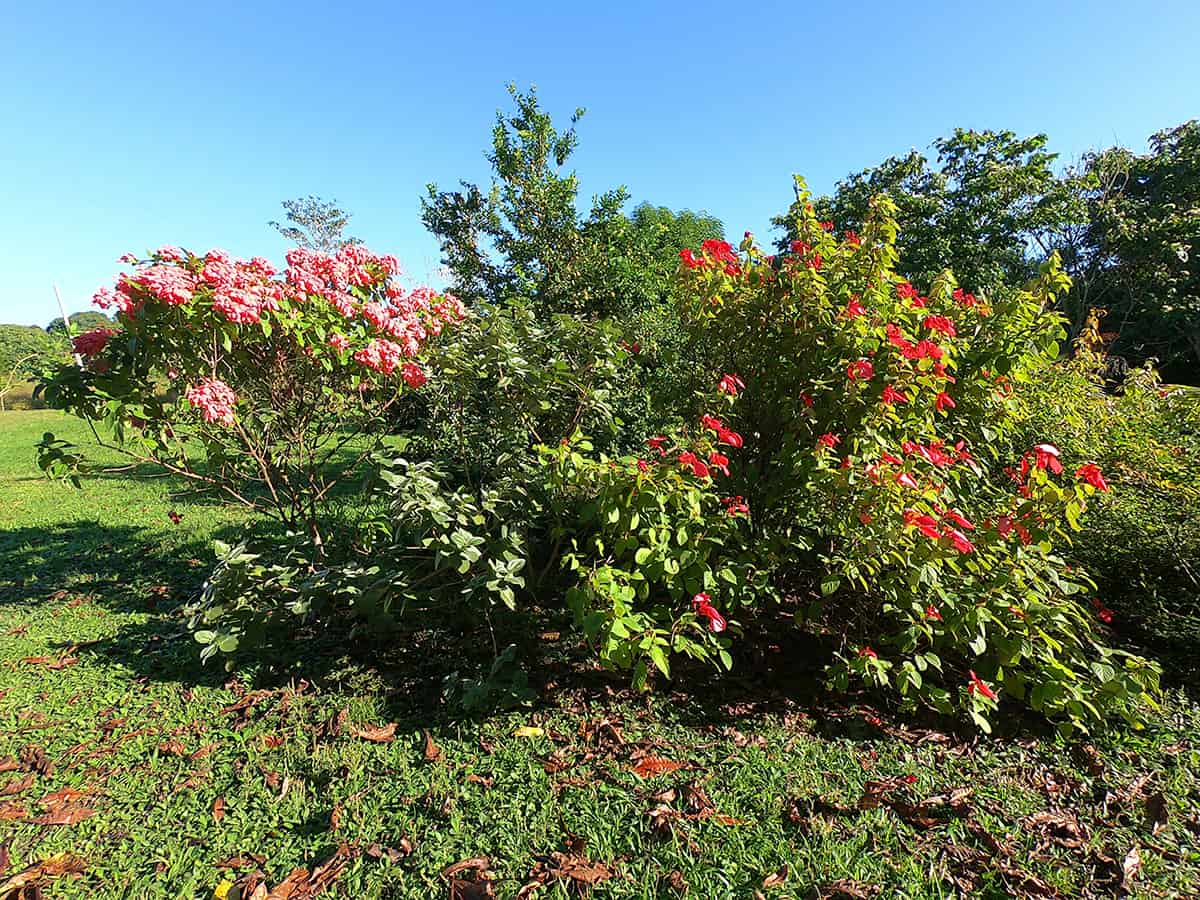
Plants that are native to tropical regions will only grow in climates where the same sorts of conditions can be replicated. Tropical climates are typically very hot in the summer, and during winter the temperatures will not plummet down to freezing. This means that most tropical flowering shrubs are best suited for growth in USDA hardiness zones 8 or 9 and above.
Outside of these hot climates, temperatures can dip too low and cause the plants to die back. However, this does not mean that you can’t grow tropical plants in cool climates. Many gardeners in colder regions will treat tropical flowering shrubs as annuals. They can be planted outside in the spring, enjoyed through the summer, and will die back at the first sign of frost.
In some cases, if the ground doesn’t freeze then the plant may reappear the following spring when temperatures begin to rise again. The alternative is to grow tropical plants indoors as houseplants; moving them outside for the spring, and inside again in late summer or early fall.
If you want to grow tropical flowering shrubs directly in the ground but your climate is too cool, you could wrap them up during colder months to protect them from frost, and use a generous amount of mulch on the soil to prevent the roots from freezing. Another option is to keep tropical plants in an outdoor, heated greenhouse.
Tropical Flowering Shrubs
Cape Plumbago
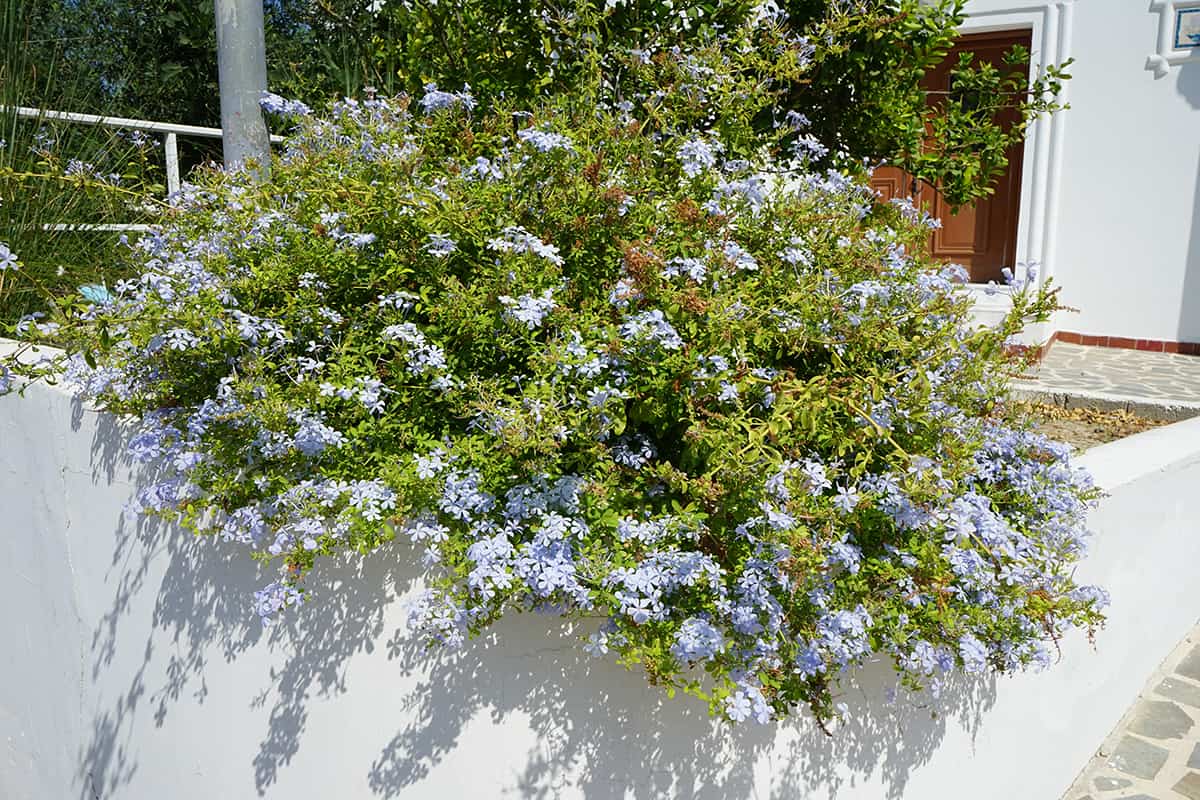
- Botanical name: Plumbago auriculata
- Family: Plumbaginaceae
- USDA hardiness zones: 9 – 11
- Mature height: Up to 13 feet
- Mature spread: Up ton 5 feet
Cape Plumbago is an evergreen climbing shrub that is native to South Africa. It has a long blooming period, flowering from early June right through to the end of October. The blooms of this plant are a deep periwinkle shade of blue, giving rise to the other common name for this plant of Blue Plumbago.
The shrub can be grown as a bush, but it is more commonly trained to grow up the trellis as a climbing plant. As a hot climate lover, it will thrive in zones 9 to 11 but is also commonly grown indoors in greenhouses or conservatories throughout the year in cooler regions. The Cape Plumbago is easy to care for and is drought tolerant. Its vivid flowers and bright foliage add an appealing tropical vibe to any garden.
Pride of Barbados

- Botanical name: Caesalpinia pulcherrima
- Family: Fabaceae
- USDA hardiness zones: 8 – 11
- Mature height: Up to 20 feet
- Mature spread: Up to 8 feet
The Pride of Barbados is also known as the Mexican Bird of Paradise and the Peacock Flower. It has telltale tropical flowers which resemble the flowers of the hibiscus. The blooms measure around 3 inches across and feature fiery red and orange petals which are delicately frilled at the edges.
These showy flowers are especially attractive to hummingbirds and butterflies. The shrub is deciduous, and in tropical environments, it will reach heights of up to 20 feet, while in milder climates you can expect it to mature at around 12 feet in height. The Pride of Barbados is tolerant of drought and extremely high temperatures and should be grown in a well-draining soil.
Esperanza
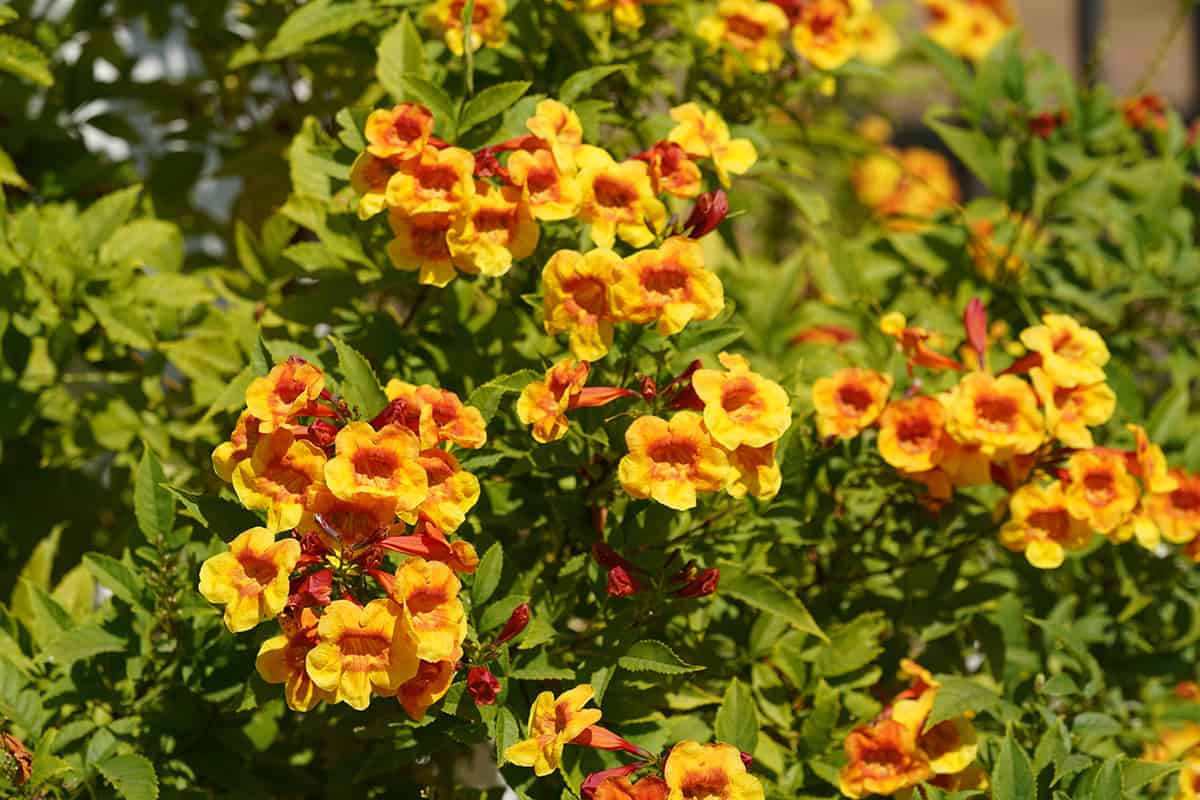
- Botanical name: Tecoma stans
- Family: Bignoniaceae
- USDA hardiness zones: 9 – 11
- Mature height: Up to 25 feet
- Mature spread: Up to 20 feet
The Esperanza plant is native to South America and the southern United States. It goes by a number of other common names, including Yellow Bells, Yellow Elder, Trumpet Flower, and Trumpet Bush. It is a prolific bloomer, producing dense clusters of trumpet-shaped yellow flowers from early spring all the way through to fall in cooler climates, and continually blooming all year round in hot climates.
It is a semi-evergreen or evergreen plant, depending on the region it is grown in, and can be grown as a shrub or a small tree. This plant is drought tolerant once established and can be positioned in full sun or partial shade, though it will flower in greater abundance with more hours of sunlight.
Bird of Paradise Bush
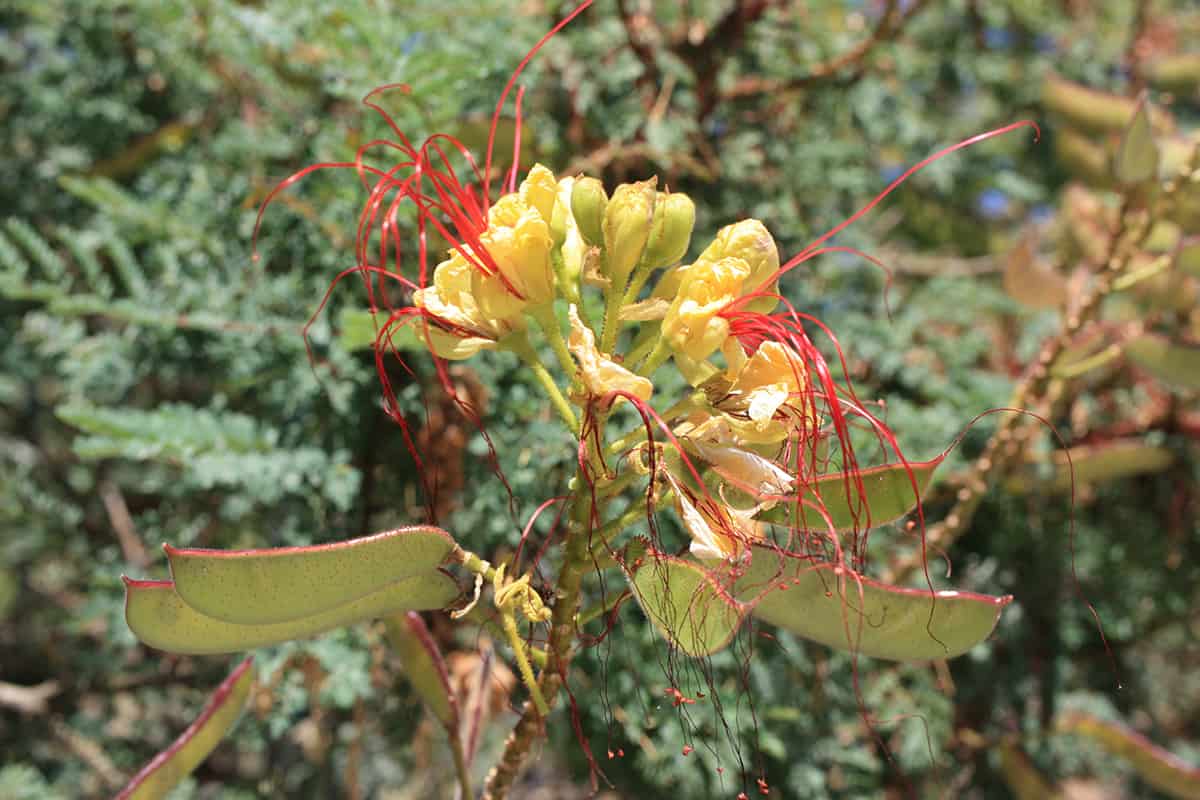
- Botanical name: Caesalpinia gilliesii
- Family: Fabaceae
- USDA hardiness zones: 8 – 11
- Mature height: 7 to 10 feet
- Mature spread: 7 to 10 feet
This shrub is native to Uruguay and Argentina. It is commonly known as the Bird of Paradise, however, it is not related to the true Bird of Paradise flower in the Strelitzia genus, and instead belongs to the pea family of plants. This tropical shrub produces extravagant flowers during summer, with long hot pink stamens which extend out of buttery yellow petals.
The foliage of the plant is also very attractive, with feathery leaves which resemble the fronds of a fern. This shrub can be grown in rows to create a flamboyant hedge, or it works wonderfully as a specimen plant. It thrives in full sun and prefers soils that are moist and well-draining, however it will become tolerant of drought once well established.
Bougainvillea
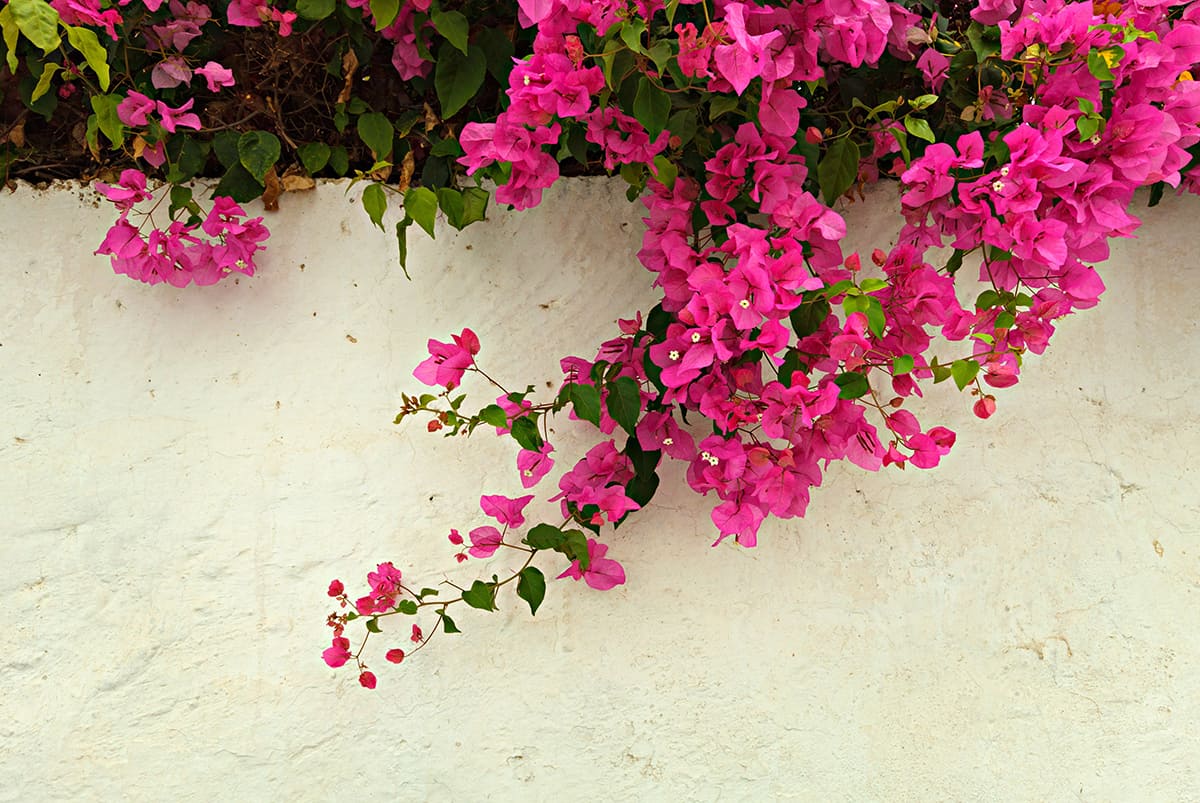
- Botanical name: Bougainvillea
- Family: Nyctaginaceae
- USDA hardiness zones: 9 – 11
- Mature height: 15 to 40 feet
- Mature spread: 15 to 40 feet
Bougainvillea is a genus of plants that is native to South America. These can take the shape of flowering shrubs, trees, and vines. What they all have in common are their exotic flowers which cover the plant with a vibrant explosion of red, pink, and purple. Although a heat-loving plant, Bougainvillea is also commonly grown in cooler climates where it is treated as an annual. It can also be kept as a houseplant, to add color and interest to an indoor space.
These plants are prolific bloomers that can flower from spring right through to fall. The intensity of their flower color is dependent on the level of light they get, so grow them in full sun for the best results.
Jungle Geranium
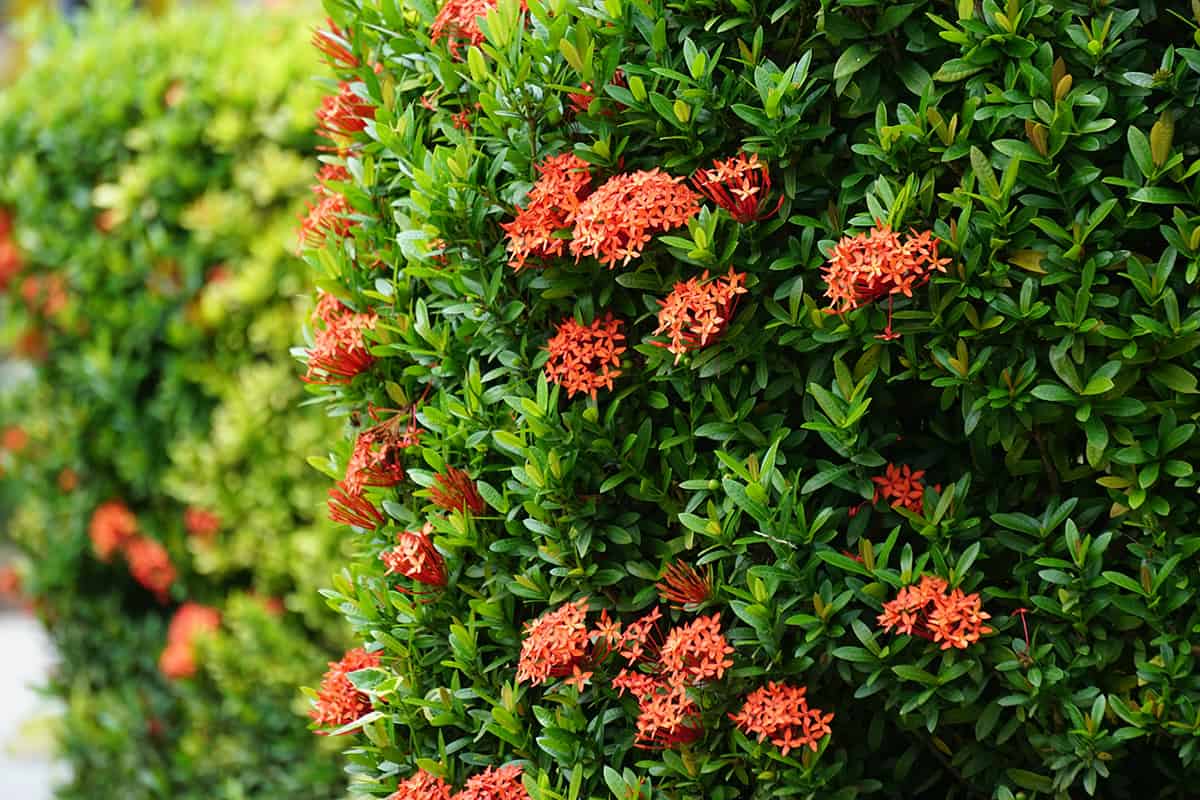
- Botanical name: Ixora coccinea
- Family: Rubiaceae
- USDA hardiness zones: 9 – 11
- Mature height: 3 to 6 feet
- Mature spread: 3 to 6 feet
This tropical shrub is native to Bangladesh, Sri Lanka, and south India, where it is a very common plant. It also goes by the common names of Jungle Flame, Flame of the Woods, or simply Ixora. The plant produces large clusters of star-shaped flowers in an array of pink and red shades. The petals have a velvety texture, contrasting against the glossy green leaves of the plant.
The shrub has a dense, rounded habit, and will grow to form thick bushes or hedging when arranged in rows. Grow Jungle Geranium in full sun, in moist, well-draining soil.
Tropical Hibiscus
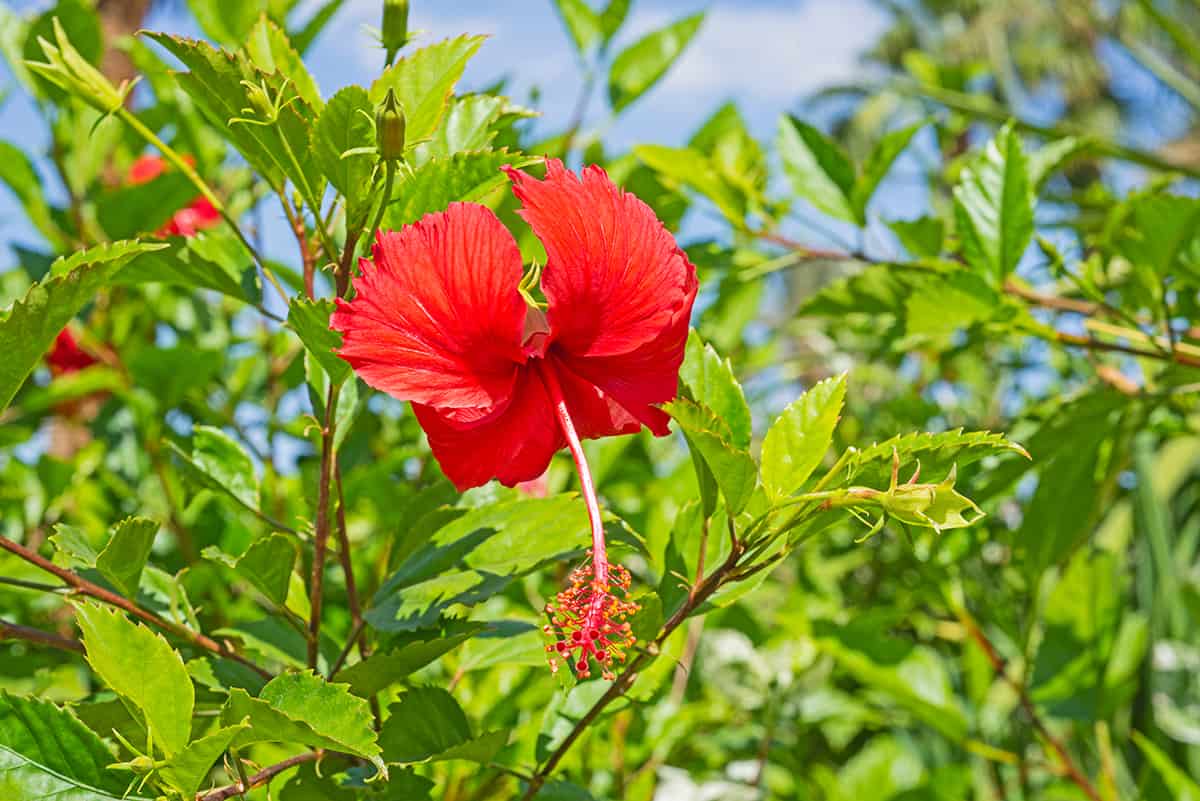
- Botanical name: Hibiscus rosa-sinensis
- Family: Malvaceae
- USDA hardiness zones: 9 – 12
- Mature height: Up to 10 feet
- Mature spread: Up to 6 feet
This tropical shrub is commonly known by a number of names, including Rose Mallow, Chinese Hibiscus, Hawaiian Hibiscus, and China Rose. It is native to Asia, and has an exceptionally long blooming period, despite the fact that each individual flower will only last a single day.
The Tropical Hibiscus produces large, showy flowers, measuring around 6 inches across. They come in various shades of pink, red, orange, purple, white, and yellow. These will bloom from early summer until the end of fall, with a generous amount of new buds forming every single day throughout the season.
In hot climates, the Tropical Hibiscus is often grown as a perennial shrub to form hedges or privacy screens, while in cooler climates this plant can be treated as an annual in borders or containers. This plant is thirsty and relies on a reasonable amount of moisture in the soil to be able to bloom. It will thrive in full sun in a northern climate, though would benefit from partial shade in southern climates.
Golden Angel’s Trumpet
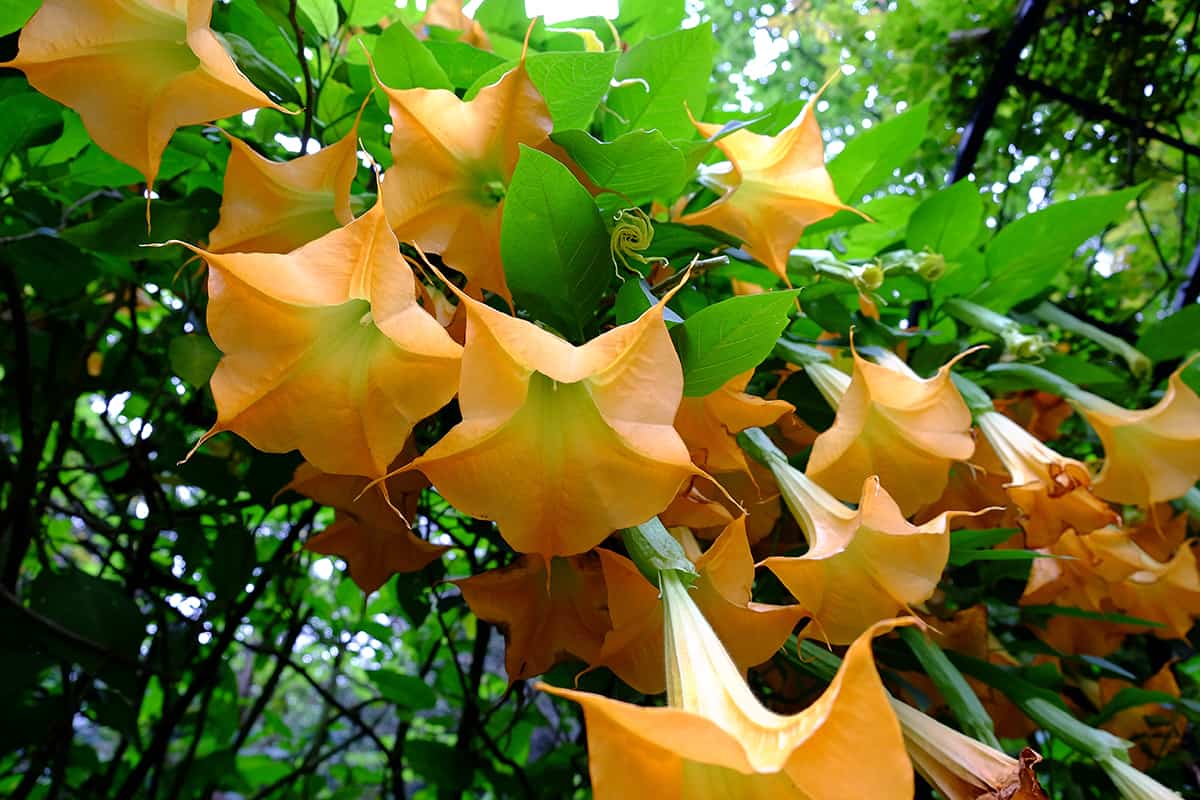
- Botanical name: Brugmansia aurea
- Family: Solanaceae
- USDA hardiness zones: 9 – 11
- Mature height: Up to 30 feet
- Mature spread: Up to 12 feet
This is an evergreen shrub that is native only to Ecuador. Since 2014 it has been listed as extinct in the wild, however, it still survives as a cultivated plant. It belongs to the nightshade family of plants, and as such all of the parts of the Golden Angel’s Trumpet are highly toxic if ingested.
The flowers of these plants are quite extraordinary, taking the shape of drooping trumpets which can measure anywhere from 6 to 24 inches in length. They are golden yellow in color and are often pleasantly fragranced. The Golden Angel’s Trumpet performs best in full sun but can also tolerate partial shade in hot climates.
Mexican Shrimp Plant
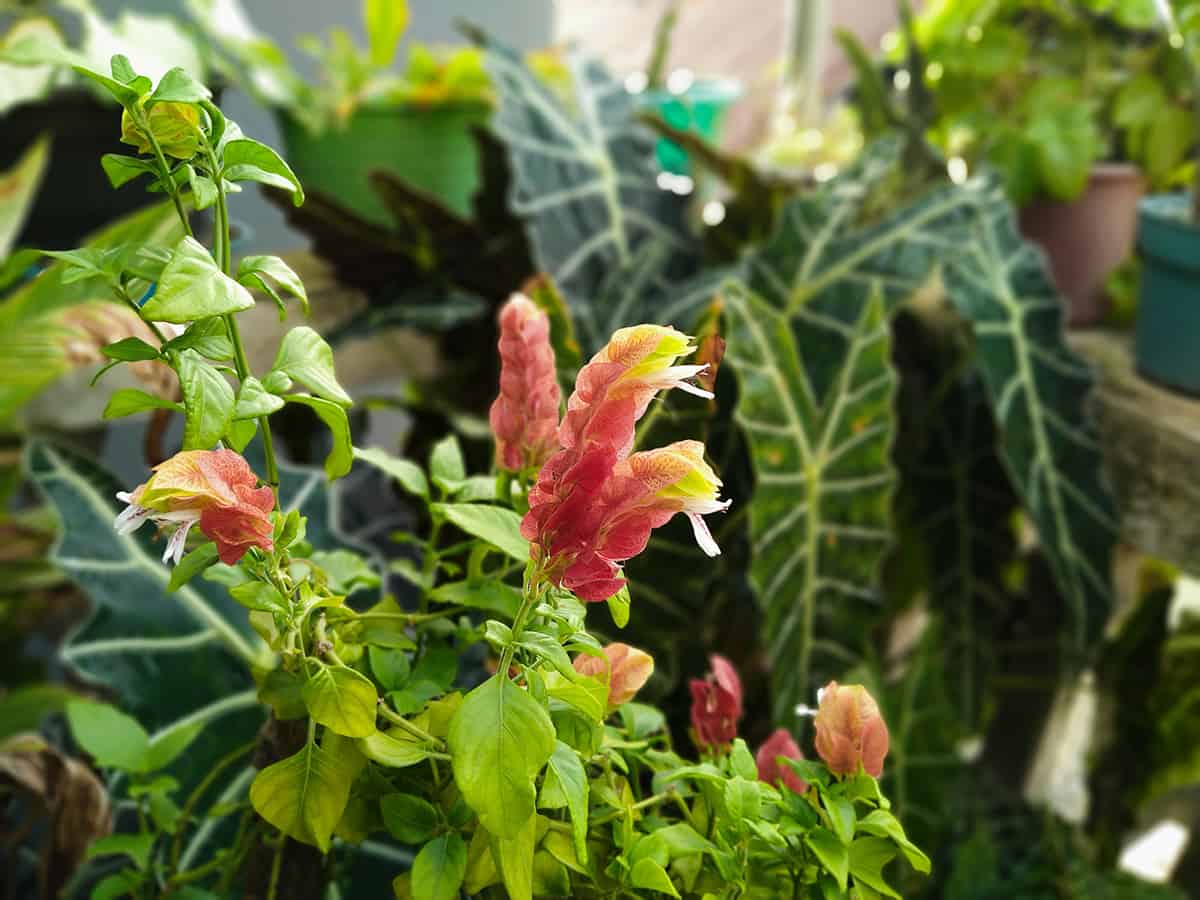
- Botanical name: Justicia brandegeeana
- Family: Acanthaceae
- USDA hardiness zones: 9 – 11
- Mature height: 1 to 3 feet
- Mature spread: 1 to 3 feet
The Mexican Shrimp Plant is native to Mexico, and has also become naturalized in Florida in the US. It is a tropical evergreen shrub that produces highly unusual flowers that closely resemble the look of cooked shrimp. The ‘shrimp’ is made up of spikes of white flowers which are separated by white bracts.
They remain in bloom for a phenomenally long time, typically around 9 or 10 months of the year from early spring through to late fall. These plants spread via suckers, and work well as low informal borders, or as container plants. They benefit from lush green leaves which form a dense background to the shrimp flowers.
The Mexican Shrimp Plant is an award-winning tropical flowering shrub, having received the Award of Garden Merit from the Royal Horticultural Society. It grows well in full sun or partial shade, particularly benefitting from afternoon shade in hot climates during the summer months to ensure the flowers don’t lose their color. The soil of this plant should be well draining and kept consistently moist for the best results.
